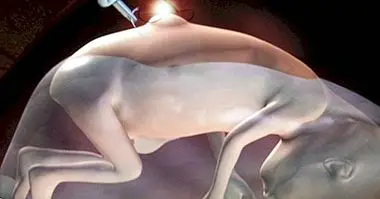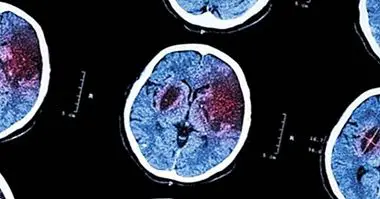Mixed anxious-depressive disorder: causes and symptoms
Anxiety disorders are the most prevalent in the general population. After them would go the depressive disorders. Traditionally it has been observed from the psychology that both types of disorder have many elements in common, being frequent that a situation of prolonged anxiety ends up generating depressive symptoms and vice versa.
But in a large number of people features of both depression and anxiety simultaneously appear, can be classified as cases of mixed anxiety-depressive disorder .
Depression and anxiety: aspects in common
The link between depressive and anxious problems is a well-known circumstance for psychological and psychiatric research. In clinical practice, rarely occurs purely , being very frequent that the depressed subjects end up developing anxiety problems. That is why in research it has been common to try to find out in which concrete aspects they are similar and in which they diverge.
One of the main elements in common between anxiety and depression is that in both there is a high level of negative affect. In other words, both disorders share the fact that both show a high level of emotional pain, irritability, discomfort and feelings of guilt and low mood.
Another common point is that in both cases people are suffering due to the consideration that they are not, will or would be able to face life or concrete circumstances of it, suffering a deep feeling of helplessness and presenting low self-esteem.
However, in depression, in addition to the high negative effect, we would also find ourselves with a low positive affect, something that would not occur in anxiety. It is what produces anhedonia and lack of energy and vital thrust. This circumstance does not appear in pure anxiety.
Something specific to anxiety that does not occur in depression (with the exception of some subtypes such as the one with psychotic symptoms) is hyperactivation. People with anxiety they notice a powerful increase in arousal , a "rush" of energy coming from the anticipation of possible damages, to which they can not give practical exit. This does not happen in depression, in which in fact the energy level of the person tends to decrease.
These are some of the elements in which depression and anxiety are similar or different . But what happens when both types of problem appear at the same time? What is the mixed anxious-depressive disorder?
Mixed anxiety-depressive disorder: what is it?
The mixed anxious-depressive disorder is a type of disorder characterized by the combined presence of symptoms of both depression and anxiety , without having either of the two greater repercussions than the other.
Typical symptoms of this disorder include depressed mood and / or anhedonia that appear along with anguish, difficulty concentrating, tension and excessive and irrational worry . These symptoms must last at least two weeks or a month and should not be due to the experience of painful experiences or the presence of other disorders.
In addition, vegetative symptoms such as tremors, intestinal discomfort or tachycardia must occasionally appear. It would be symptoms that agree with a very high level of negative affect, appearing in part also the hyperactivation proper to anxious disorders and the low positive effect of depressants.
The diagnosis of mixed anxiety-depressive disorder
To diagnose mixed anxiety-depressive disorder the symptoms suffered can not meet all the necessary conditions to identify with either of the two Disorders may not be severe enough to make it necessary to make two diagnoses, one of depression and the other of anxiety.
Another characteristic, of great importance, is that both types of symptoms must appear in the same period. This consideration is important since it allows to distinguish This disorder leads to the appearance of anxious symptoms as a consequence of depression or depressive symptoms due to the persistence of depressive symptoms.
symptom
At a vital level, this disorder is experienced as distressing by those who suffer it, not being rare that those suffering from it end up developing a high irritability, autolytic thoughts, substance use as an escape route, deterioration of work or social environments, lack of Personal hygiene, insomnia, hyperphagia and hopelessness.
In spite of this, as a general rule, they are not considered by themselves to be serious enough to attend the consultation. In fact, it is more frequent to arrive at the diagnosis after a visit to the doctor because of the vegetative problems that causes that by the cognitive problems.
Condition of the disorder in the most common diagnostic classifications
The category of mixed anxious-depressive disorder has aroused controversy in its conception, not being collected by all existing diagnostic classifications . It is not that their existence is not recognized, but sometimes it has been considered to be a depressive disorder with secondary anxious characteristics and not a single disorder.
In the case of the International Classification of Diseases, carried out by the World Health Organization, the mixed anxiety-depressive disorder has been and continues to be recognized and included in both the ICD-10 and the ICD-11.
In the case of the other great diagnostic classification of mental disorders, the DSM , in the drafts of his fifth version was also going to be included. However, in the final version it was decided not to include the mixed anxious-depressive disorder as a disorder per se, because it is considered that in the studies carried out the data obtained are not totally reliable. Instead, the "with symptoms of anxiety" specification has been added to mood disorders to refer to patients with both depressive and / or bipolar and anxious characteristics.
Applied treatments
As it mentioned above, anxiety and depression are often linked and they can appear together in those who suffer them. But despite this, they are still disorders with their own characteristics, with different treatments applied in each one.
In the case of mixed anxiety-depressive disorder, its treatment is complex due to this difference, having to use own strategies of each type of disorders. Specifically, a strategy based on cognitive behavioral therapy has been used successfully, sometimes in combination with pharmacological treatment.
At a psychological level, it is useful to practice activities that restore the feeling of control to the patient, increase their self-esteem and make them see the world in a more realistic way.
Psychoeducation is generally used , through which patients are explained the characteristics of their problem, it can be very useful for them to understand what is happening to them and that they are not the only ones who suffer from it. Afterwards, it is usual to treat both anxious and depressive symptoms, using exposure to avoidable situations, training in breathing and relaxation, and self-instruction techniques for the former.
In the problematic ones of depressive nature it acts involving subjects in positive and rewarding activities and cognitive restructuring is used to move towards acquiring new patterns of thinking that are more adaptive than those used up to now. It has also been observed that group therapy greatly helps to improve symptoms and to identify maladaptive thinking patterns and change them for others.
A pharmacological level has shown that the application of SSRI is useful for the control of symptoms, by inhibiting the reuptake of serotonin in a specific way and successfully combat both depressive and anxious symptoms.
Bibliographic references:
- American Psychiatric Association. (2013). Diagnostic and Statistical Manual of Mental Disorders. Fifth edition. DSM-V. Masson, Barcelona.
- Echeburúa, E .; Salaberría, K .; from Corral, P .; Cenea, R. & Barasategui, T. (2000). Treatment of mixed anxiety and depression disorder: results of an experimental investigation. Analysis and behavior modification, vol.26, 108. Department of Personality, Evaluation and Psychological Treatments. Faculty of Psychology. University of the Basque Country.
- World Health Organization (1992). International Classification of Diseases. Tenth Edition. Madrid: WHO.
- Santos, J.L. ; García, L.I. ; Calderón, M.A. ; Sanz, L.J .; de los Ríos, P .; Left, S .; Román, P .; Hernangómez, L .; Navas, E .; Thief, A and Álvarez-Cienfuegos, L. (2012). Clinical psychology. CEDE Preparation Manual PIR, 02. CEDE. Madrid.



















